As we enthusiastically enter the New Year, it starts with a promising note- our country is going to witness the biggest event live at 12:20 pm on January 22. Yes, we are talking about the consecration ceremony of the idol Ram Lalla at Ram Janmabhoomi, Ayodhya.
From the massive celebrations nationwide to Ayodhya becoming the new cultural and tourism hub and the religious leaders slamming politicisation, the melody of Ram Aayenge is everywhere. The buzz and euphoria can be felt in every corner of the streets in Ayodhya and other parts of the country.
However, the Ram consecration has divided people claiming – “politics over religion”. Some of the Ayodhya saints have decided to skip the ceremony on the grounds of political leaders “interfering in religious affairs”.
“It’s against the sacred Hindu scriptures to hold the ceremony before the temple construction is complete”, one of the saints mentioned.
Although it’s not new for Ayodhya, the ancient city has been a subject of debate for centuries. Nevertheless, it’s going to be a profound moment for millions of Hindu devotees. Prime Minister Narendra Modi is gearing up to address the nation, focussing on the development and cultural heritage that will take India forward. Keeping this in mind, PM Modi begins his 11-day fast ahead of the event and urges people to light up their homes to celebrate this glorious festival- The Homecoming of Ram!
More than 1.5 lakh devotees are expected to descend to the temple town; such is the grandeur of Ayodhya’s Ram Mandir. Let’s unravel its timeless legacy that weaves together the nation’s history, spirituality, and communal harmony.
Table of contents
- Ayodhya Ram Mandir History
- Important Facts on Shri Ram Mandir, Ayodhya
- New Dawn- Ayodhya Ram Mandir Construction
- Ayodhya Ram Mandir Temple Architecture
- Ayodhya Ram Mandir Building Description
- Ayodhya City Makeover!
- Ayodhya Ram Mandir Donations
- How to Reach Ayodhya Ram Mandir?
- Ram Mandir – The Promise!
- FAQ’s about Ram Mandir Ayodhya
Ayodhya Ram Mandir History
Ram Mandir’s history in Ayodhya is centuries old, finding its mythical roots in the Ramayana, as the birthplace of Lord Rama, a revered figure in Hinduism.
Nestled on the banks of the Surayu River, Ayodhya in Uttar Pradesh, India, is believed to be the Ram Janmabhoomi. The ancient town served as the central setting in the epic Ramayana, depicting the life journey of Lord Rama, adding its status as a sacred site.
The original temple is said to have been constructed at the beginning of the 12th century. However, the construction of the Babri Masjid, a mosque, in the 16th century led to a long, legal battle. This holy site became the focal point of a significant historical and religious debate in later centuries.
The Demolition of Babri Masjid and Aftermath
The Mandir-Masjid dispute gained significant momentum in the 20th century, becoming a political battleground bristled with communal tensions and legal battles. Then, the conflict reached a tragic peak on December 6, 1992, when the Babri Masjid was demolished. This event was a watershed movement, triggering communal riots across the country and fracturing India’s socio-political fabric.
Legal Battles and The Verdict
The aftermath of the demolition engulfed the nation in long legal battles and disputes for decades, questioning religious freedom, national security and identity. The matter eventually reached its pinnacle with the Supreme Court of India and, after a thorough examination of evidences and documents, delivered the historic verdict on November 9, 2019. The court ruled in favour of the construction of Ram Mandir at the site, ending a prolonged legal and emotional odyssey, while allocating a separate piece of land in Ayodhya for building a mosque.
Important Facts on Shri Ram Mandir, Ayodhya
Ayodhya Ram Mandir is a testament to India’s rich cultural and spiritual heritage. Following are the fundamental facts of Ram Temple that blend architectural craftsmanship and modern technological advancements.
| Chief Architect | Chandrakant B. Sompura (CBS) |
|---|---|
| Construction Company | Larsen and Toubro (L&T) |
| Project Management Company | Tata Consulting Engineers Limited ( TCEL) |
| Design Consultants | IIT Chennai, IIT Guwahati, IIT Bombay, CBRI Roorkee, NGRI Hyderabad, SVNIT Surat. |
| Art Sculptors | Arun Yogiraaj (Mysore), Satyanarayan Pandey and Ganesh Bhatt. |
| Total Area | 70 Acre (70% green Area) |
| Temple Area: | 2.77 Acre |
| Mandir Dimensions: | L– 380 ft. W – 250 ft. H – 161 ft. |
| Architectural Style | Indian Nagara ‘shaili’ |
| Special Features | 2 Sewer Treatment Plants
1 Water Treatment Plant Ardent Power Supply |
New Dawn- Ayodhya Ram Mandir Construction
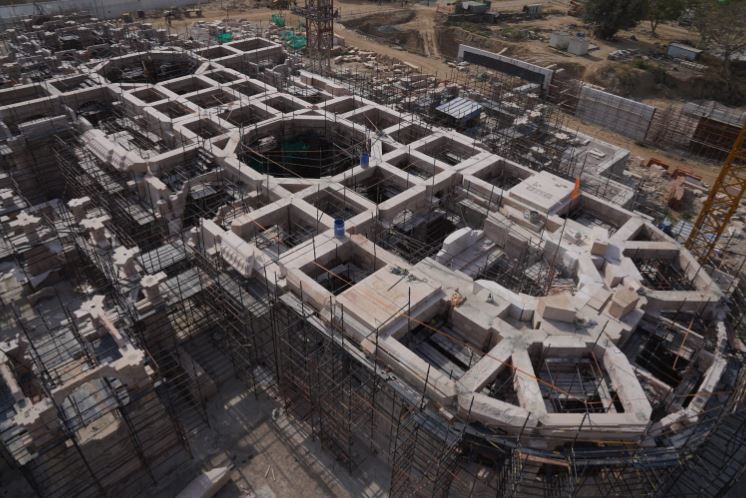
Credits- twitter.com
After the groundbreaking SC verdict, the construction of the divine temple at the Janmabhoomi site officially commenced in August 2020. It was followed by the Bhoomi Pujan ceremony performed by Prime Minister Narendra Modi.
The temple’s construction and consecration ceremony are under the Shri Ram Janmabhoomi Teerth Kshetra Trust. The Ram Mandir complex covers about 70 acres, and different temples will be constructed within it. As per the reports, the Ram Mandir budget is between Rs 1,400 to Rs 1,800 crores.
Spanning 2.7 acres, the Ayodhya Ram temple is touted to be a combination of India’s architectural heritage blended with innovative design. The Mandir’s architecture is inspired by classical Hindu temples, built with traditional craftsmanship and modern techniques, celebrating the glorious past and technological prowess.
Ayodhya Ram Mandir Temple Architecture
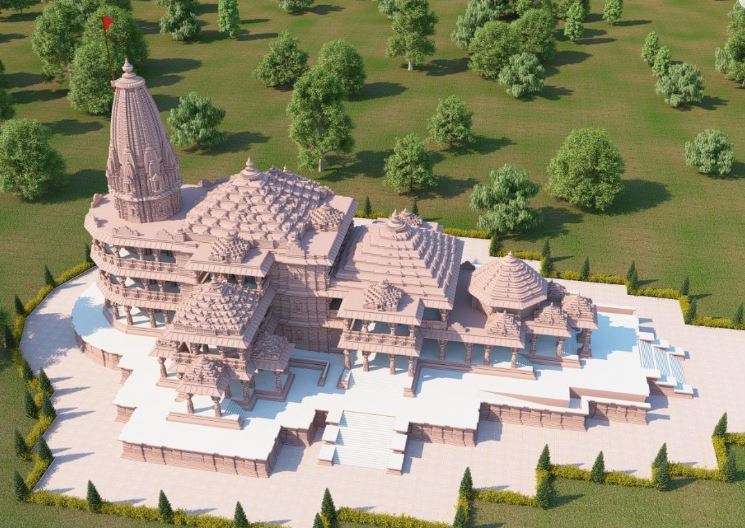
Credits- twitter.com
Designed by the Sompura family and Larsen & Toubro construction company, the Ayodhya Ram Mandir is poised to be a visual marvel. The temple complex is characterised by exquisite craftsmanship, intricate design, grand dimensions, imposing spires, and delicate sculptures.
The Sompura family are renowned for temple architecture, crafting more than 100 temples, including the notable Somnath temple. The chief architect Chandrakant Sompura, assisted by his sons, revised the original 1988 design and tweaked certain modifications.
Temple Design
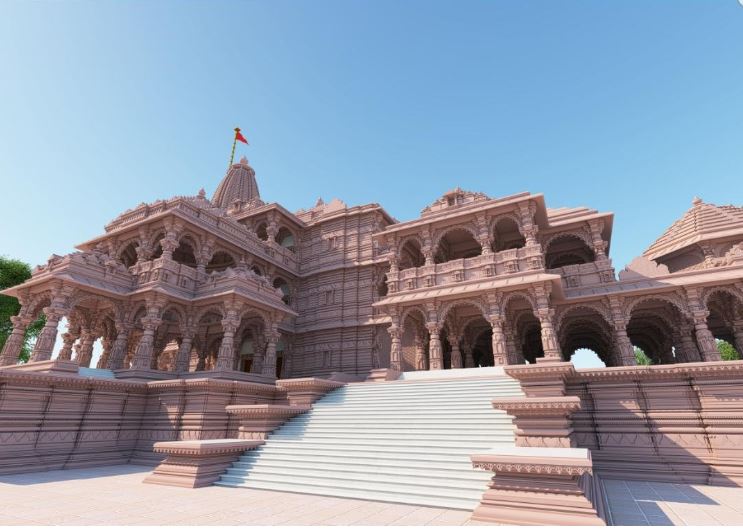
Credits- twitter.com
The temple’s aesthetics is mainly shaped by the Nagara style (a type of temple design with tall, multiple shikharas), and there’s also a touch of the Dravidian style, which involves gopurams.
Rooted deeply in Hindu scriptures, the temple design adheres to Vastu Shastra principles, harmonising positive energy. The larger expanded temple design now has three floors and features five carefully crafted domes (mandapas) and ornate pillars, enhancing its overall visual beauty. The central spire, known as shikhara, rises to a height of 161 feet, making it the world’s third-largest Hindu shrine.
Ayodhya Ram Mandir Building Description
The most astonishing element of the temple is the octagonal shape of the Garbha griha (sanctum sanctorum) that houses the main deity- the idol of Ram Lalla ( infant ideal of Lord Rama) in keeping with the tradition of Vishnu Temples.
Do you know what makes the structure of Ram Mandir unique? It pays homage to the Indian traditional and sustainable practices, opting for stone, wood, cement, copper and gold while excluding iron and steel. The combination of these materials with meticulously detailed carvings elevates the magnificent appeal.
Carvings and Details
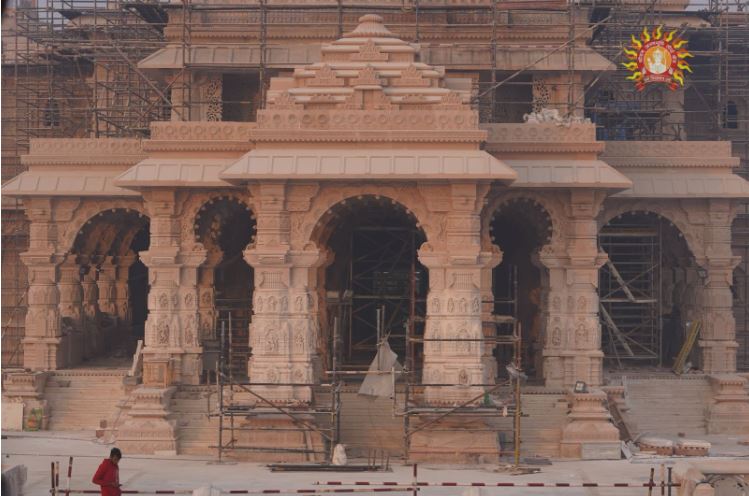
Credits- twitter.com
The Ram temple’s superstructure is adorned with pink marble stone – Rajasthan Bansi Paharpur stone, celebrated for its enduring beauty and strength. These rare pink sandstones are found in the Bharatpur District in Rajasthan and have been incorporated in other imposing structures, like Lal Qila Agra, the Parliament Complex and Akshardham Temple.
The walls and pillars are enriched with rich renderings and delicate carvings, depicting scenes from the Ramayana, Hindu deities, and floral motifs, highlighting our vibrant legacy.
Cultural Extravaganza
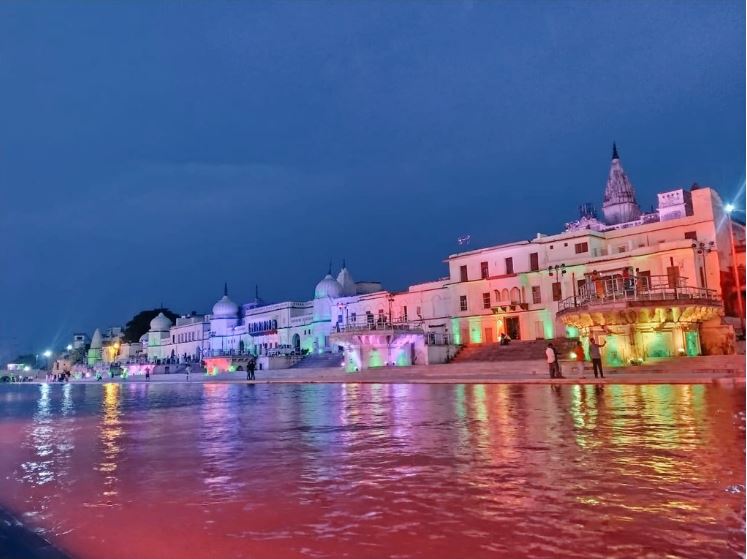
Credits- twitter.com
Beyond its stunning physical structure and heritage legacy, the Ayodhya Ram Mandir embraces profound cultural and symbolic significance. The highly anticipated occasion will be marked by celebrations and festivals, fostering a joyous environment and visual spectacle.
Preparations are in full swing, and the invitation to the event has been sent to political leaders and other dignitaries from across the globe. The 7,000 guest list includes industrialists, celebrities, sportsmen, army officers, spiritual leaders, and awardees.
Vedic rituals for the Pran-Pratishtha ceremony will begin from the occasion of Makar Sakranti, January 14 to January 22, marking the Amrit Mahotsav. The temple, however, will be functional and open for visitors from January 24. The main ceremonial event will be followed by different cultural delights, including the Ram Charan Paduka Yatra, Ram Leelas, and much more.
PM Modi has already kickstarted the celebrations and rituals while participating in the Swatchhata Abhiyaan, mopping the premises of Kalaram Temple in Nashik. He appealed to carry out cleanliness activities in temples across the country.
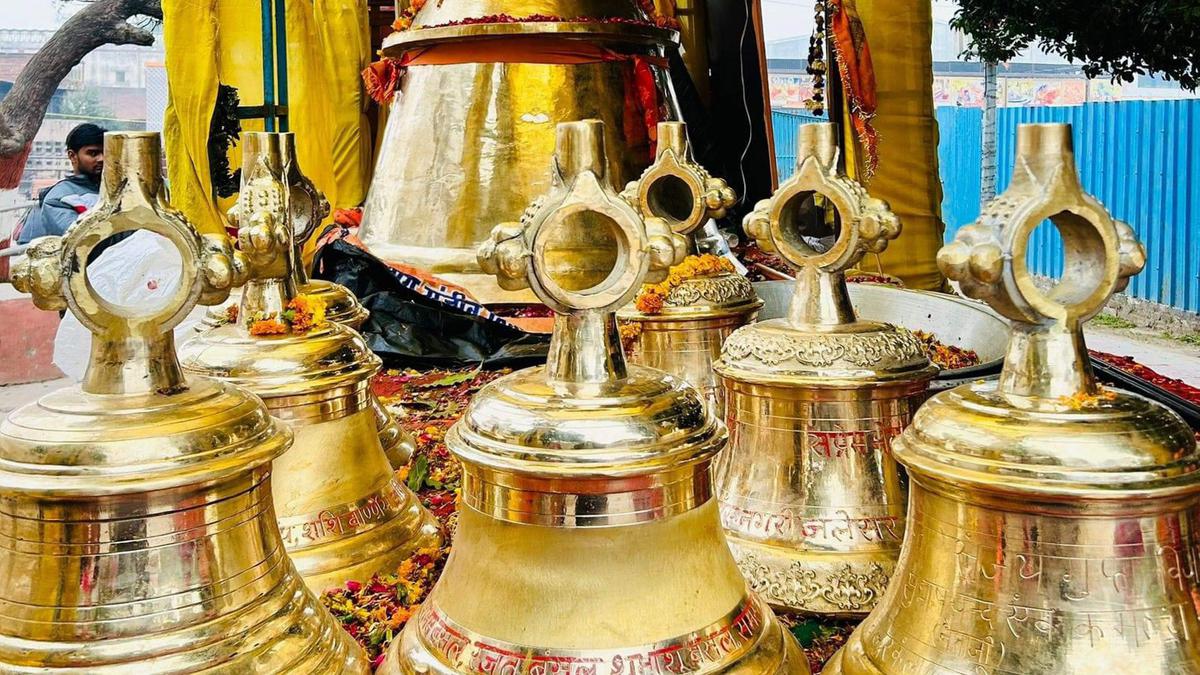
Credits- The Hindu
Adding to this religious fervour, Ayodhya Ram Mandir received invaluable gifts from all parts of the country and abroad. A heartfelt symbol of unity, harmony, and devotion!
The unique gifts include a temple bell weighing 2,100 kg carved of ashtadhatu (octo-alloy), an alloy made of eight metals (gold, silver, copper, lead, zinc, tin, iron, and mercury). It is frequently used to create metal idols for Jain and Hindu temples in India.
Another enormous gift is a 500 kg Nagada (temple drum) made of gold foil from Gujarat and a 108-foot-long incense stick that will last 45 days, spreading its fragrance over several kilometres. Other souvenirs are a 10-foot-high world’s largest lock and key, gold footwear, a clock, and more.
Not only this, the Ram temple received generous offerings from the neighbouring countries, Nepal (the hometown of Goddesses Sita) and Sri Lanka.
Ayodhya City Makeover!
Ahead of the ceremony preparations, Ayodhya is witnessing a transformation into a dynamic city. The redevelopment of the temple town as per the Master Plan 2031 with an investment of over 80,000 crores broadly categorises into themes – Embracing the Modern and Cultural Ayodhya while boosting the business and economy in the entire region.
It’s interesting to note, that the anticipation of the Ayodhya Ram Mandir has sparked a surge in hotel prices along with an incredible increase in online bookings, clearly indicating the widespread excitement of the event.
Global Acknowledgment
The festive spirit is high not just at Ram Janbhoomi but beyond the nation’s borders, with celebrations reaching a crescendo in numerous countries as a global event. With the live streaming of the ceremony at iconic Times Square in New York City, the Ayodhya Ram Mandir’s stature is poised to gain worldwide recognition as a beacon of spiritual and cultural icons. The members of the Hindu American community organised large-scale auto rallies in cities like Houston, Chicago, and other locations.
Paris, the city of love, is joining in on the festivities. The Indian community there is planning a Rath Yatra, scheduled 24 hours before the consecration ceremony on January 21. It will include a detailed pooja arti and a cultural celebration.
Ayodhya Ram Mandir Donations
The construction of Ayodhya’s Ram Mandir has witnessed an overwhelming response from Hindu devotees in terms of donations. Contributions for the same have surpassed Rs 5,500 crore and still counting.
How to Reach Ayodhya Ram Mandir?
Ayodhya City is linked to other parts of the country through all modes of transportation, i.e. road, train, and airways.
- By Air:
- Maharishi Valmiki International Airport Ayodhya Dham (17 km)
- Gorakhpur Airport To Ayodhya Ram Mandir (139 km)
- Chaudhary Charan Singh International Airport, Lucknow (156 km)
- By Train: The nearest Ayodhya Junction is well-connected to all major cities in India.
- Ayodhya Junction (2.5 km)
- Gorakhpur Junction (113 km)
- Lucknow Railway Junction (144 km)
- By Road: Several state-run and private buses, taxis and private vehicles are available for Ram Mandir station. Affordable bus services are also available from neighbouring towns and other parts of the country to reach the Ayodhya Ram Mandir.
Ram Mandir – The Promise!
With the ‘Pran Pratishtha’ ceremony of Lord Ram on January 22 drawing closer, the air is thick with anticipation. Hindu devotees across the globe are counting the days and bustling with excitement and preparations for this momentous occasion. After years of longing, the dream is finally becoming a reality. Held by devotion and faith, the ardent devotees of Lord Ram are rejoicing and waiting eagerly to welcome their deity back home. This moment will bring a paradigm shift in the country, strengthening the bond and stepping into a progressive future where tradition and modernity are united.
FAQ’s about Ram Mandir Ayodhya
Q1. When will Ram Mandir Ayodhya be completed?
The first phase of the construction will be completed by January 22, 2024, and the other phases will be completed by the end of the year.
Q2. What is the height of Ram temple in Ayodhya?
With three floors, the total height of the Ram Mandir, including its peak will be 161 feet.
Q3. How much work is completed on Ram temple in Ayodhya?
As per the latest news, the ground floor is ready, and the first and second floors will be completed by the end of 2024.
Q4. When and who constructed the Ram Mandir?
Shri Ram Janmabhoomi Teerth Kshetra Trust oversees the construction of the new Ram Mandir.






















